| |
|
|||||||||||||||||||||||||||||||||||||||||||||||||||||||||||||
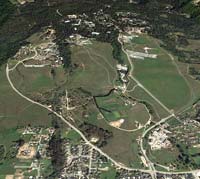 |
| The UCSC campus (in 2003) [enlarge] |
However, in the first of many unanticipated outcomes, the university did not prove to be a draw for industrial development. Instead, it was focused on classical liberal arts education within separate small colleges of 600 to 800 students, scattered around a core of common natural science, social science, humanities, and library buildings in the center of the campus. The idea was to combine the best of a small liberal arts education with the upper-division, research-oriented classes that a large-scale university has to offer.
So the campus became a magnet for the kind of liberal-minded people who run bookstores, music/record stores, art galleries, head shops, and student-oriented cafés, bistros, and bars. Still, the arrival of the university did help to revitalize what had come to be a run-down beach and retirement town with empty storefronts in the central business district. Swallowing their disappointment, city officials greeted the first contingent of 650 eager and well-scrubbed "pioneer" students, as they were called, with joy in the fall of 1965.
The student body was unique in many ways. Because of the emphasis on the liberal arts, with no applied or technical programs, and no athletic scholarships (or even any inter-collegiate teams), the students tended to be searchers and seekers who did not yet have focused educational or career plans. The early adoption of a pass/fail grading system, along with detailed "narrative evaluations" of the students' performance in each class in lieu of letter grades, added to the campus's appeal to many idealistic students of that era. The initial absence of fraternities and sororities, which were actively discouraged in order to make the small colleges the center of student life, also contributed to a unique collegiate atmosphere, at least for a public university of any size.
The students arrived with positive attitudes toward authority figures and were primarily concerned with educational issues, not politics, but all that began to change from almost the moment the first quarter began. The army had sent 3,500 combat troops into Vietnam in the spring of 1965, hardly enough to make most students sit up and take notice, but the deployment grew to 175,000 by the end of that year and 350,000 by mid-1966; in the next few years, that number would grow to over half a million. This huge build-up was accompanied by a massive bombing campaign that was graphically portrayed on television for everyone to see. By the end of the first academic year, the nicely dressed and well-mannered students had become long-haired, scruffy, militant, and strongly opposed to the Vietnam War. The possibility of being drafted, the fate of loved ones who were sent to Vietnam, and the seeming futility of the war became burning issues over the next few years. So did continuing concerns with civil rights, the environment, feminism, and the plight of low-paid farm laborers, leading some of the most politically committed students to work in César Chávez's long struggle to create the United Farm Workers through the use of strategic nonviolence and boycotts.
Early history of UCSC
The history of the campus, especially its exciting early years, is best told through the oral histories and pictures on the web site of the UCSC library's Regional History Project, which includes interviews with the founders of the campus that can be downloaded as PDFs, as well as interviews with some of the early faculty.
The founding of a unique liberal arts campus at this particular moment in history led to a politically liberal and activist student culture that probably would not have developed otherwise. True, there were activists on many other campuses throughout the country in the two or three years before the highly visible and militant Students for a Democratic Society imploded and splintered into rival Maoist factions in the summer of 1969. However, this leadership role was not sustained on very many campuses, and even more important, it rarely became part of local electoral movements in the way it soon did in Santa Cruz. The coincidence of a new campus of highly liberal students in an institutional framework that did not feature sports or a fraternity/sorority system made UC Santa Cruz relatively unique for the next 20 to 25 years.
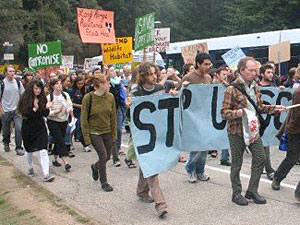 |
| UCSC's activist tradition continues (2007) |
This claim is supported by the findings on the political attitudes of incoming college freshmen in 1970 by the Higher Education Research Institute at UCLA. In that survey, 41.0% of the first-year students at 536 American universities considered themselves to be "liberal" or "far left," whereas the figure was 82.7% for Santa Cruz. Santa Cruz was not only twice the national norm, it was higher on the liberal-left percent than the best-known "radical" campus of the time, the University of California at Berkeley. In 1972, the first year for which we could obtain these numbers for UC Berkeley, 56.5% of its first-year students considered themselves liberal or left, compared to a much higher figure of 80.4% at UC Santa Cruz for the same year.
The ongoing surveys by the Higher Education Research Institute also show that these differences were maintained over the decades even though there was a gradual decline in student liberalism at Santa Cruz from 1972 to 1982, as there was at other colleges and universities. The "liberal/far-left" figure reached a low of 49.4% at Santa Cruz in 1982, but by 2004, it had crept back up to 60.4%, still the highest figure of all University of California campuses by 7 percentage points, and still more than double the nationwide average for all first-year students in public universities. See the table below for details.
| Percentage of incoming students who describe themselves as "liberal" or |
| 1972 | 1974 | 1978 | 1982 | 1990 | 1996 | 2002 | |
|---|---|---|---|---|---|---|---|
| All public | 39.5% | 33.9% | 28.0% | n/a | 28.3% | 26.1% | 27.7% |
| Selective public | n/a | n/a | n/a | 24.0% | 32.1% | 32.7% | 32.6% |
| UC Santa Cruz | 80.4% | 77.2% | 63.7% | 49.4% | 58.2% | 61.5% | 58.1% |
| UC Berkeley | 56.5% | 49.1% | 37.7% | 32.9% | 42.9% | n/a | 45.2% |
| Source: CIRP Freshman Survey, Higher Education Research Institute, UCLA |
When the Santa Cruz growth coalition put forth its plans to widen highways, build new access roads to the beach and boardwalk area, and expand the downtown, it faced an unexpected challenge from a faculty-staff-student coalition that joined with neighborhood activists and environmentalists to tip the political scales against growth.
However, this does not mean that all members of the university community supported the gradually coalescing opponents of the growth coalition. Most top administrators, many with close ties to the local Chamber of Commerce, opposed the new turn of events. They had neither desired nor anticipated the activism that emerged. Moreover, the university administration itself was viewed as part of the growth coalition by some faculty and many students because it had its own growth agenda, which would have a major impact on downtown infrastructure and the availability of housing. Although the original plan for the Santa Cruz campus envisioned rapid growth throughout the 1970s and 1980s, that goal came to be opposed by most city residents and many faculty and students. When the pressures on the university administration were combined with a lower than expected number of new college students in California by the early 1970s, the growth goals for the campus were lowered from 27,500 to 7,500 for the year 1990. The net result was much slower growth in the 1970s, with enrollment creeping up from 3,713 in 1970 to 6,364 in 1980, which meant that the university's size did not become a target of controversy again until the 1980s.
The neighborhood and environmental activists received their biggest boost from an especially activist core of university faculty and students in a new, and unique, undergraduate department, Community Studies, created in 1969 to allow its majors to focus their attention on local communities. With its special emphasis on the social circumstances and cultures of low-income or marginalized people, it was a natural ally of any beleaguered neighborhood. It not only focused on the community level, but it also emphasized internships and field studies, forms of participant learning that had slowly gained acceptance within universities over the decades as a way to learn through practical experience and at the same time earn academic credit. It was the first fully-funded program of its kind in an American university, and it had few imitators thereafter.
Community Studies
For details on the history of the Community Studies program, read the PDF article entitled "Community and the World: Participating in Social Change", available on the UCSC Community Studies web site.
The fact that Community Studies students, and not the faculty, chose their field sites made it possible for some of them to become active participants in the political activities taking place in Santa Cruz, despite protests about their presence from the downtown business community and elected officials — those protests were brushed aside, however reluctantly, by top university administrators. Although most students chose sites outside of Santa Cruz, including many in foreign countries, the program nonetheless provided tens of thousands of hours of organizing and staff support for the efforts of a wide range of activist and nonprofit groups in Santa Cruz, non-electoral and electoral, for the next 21 years. Between 1969 and 1990, over 1,000 students did field studies in Santa Cruz County, mostly in nonprofit service organizations, but many in political and advocacy groups. Dozens of these students went on to become top leaders in activist groups throughout the country. Two became city managers in Northern California cities, another served as the mayor of San Jose from 1999 to 2006, and two became mayors of Santa Cruz.
However, the future of Community Studies may be in jeopardy. When faced with massive budget cuts in 2008-2009, UCSC moved to eliminate the relatively tiny Community Studies program — one of its most innovative programs, and the only one like it in the entire university system. In the name of saving perhaps $75,000-$100,000 per year, a long-time staff member was fired, and other staffers who are critical for students in the program saw their hours cut back.
The situation was all the more disgraceful because UCSC had just added some new high-tech programs in the natural sciences and engineering, to provide more "balance" against its touchy-feely and experiential side; lopping off part of that touchy-feely side throws things out of balance in the other direction. Now the campus wants to add a management school as well: training community organizers is replaced by a hope to train corporate managers.
Saving Lighthouse Field
West Cliff Drive
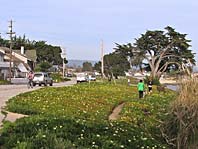 |
| [enlarge] |
Santa Cruz's famous West Cliff Drive hugs the shoreline between the Wharf and Natural Bridges State Park, passing by Lighthouse Point and the world-famous surf break known as Steamer Lane (YouTube video, 2:06).
The ratification of the 26th amendment in 1971, giving 18-year-olds the right to vote, set the stage for a new era in Santa Cruz politics, but it did not come automatically. One of the main triggers to activism was a plan backed by the local Chamber of Commerce to put a hotel and convention center on Lighthouse Field, which consisted of 37 acres of fallow coastal farmland alongside West Cliff Drive, a scenic two-lane city road that winds along the low cliffs overlooking Monterey Bay on the west side of the city, about a mile from the boardwalk and two miles from downtown. The site lies directly across the road from one of the city's most beautiful bay vistas and hallowed surfing areas, where visitors can park their cars near the lighthouse and watch the sea lions on Seal Rock and the surfers in Steamer Lane.
The plan aroused opposition from the neighborhoods near the area and also from environmentalists. They figured they had a very good chance to stop the project because a newly created California Coastal Commission had the final say on any development on land within 1,000 feet of the ocean. After electing three pro-environment members to the city council in 1973 — thanks to the boost they received from UC Santa Cruz voters — the neighborhood and environmental activists knew that they could put together an electoral majority for an initiative rejecting the new convention center. Soon thereafter, in 1974, 68% of the city electorate endorsed just such an initiative that prohibited city participation in the project. Even a city planning commission appointed by pro-growth council members voted 5-2 against the convention center, but the city council approved it anyhow by a 4-3 margin in front of 3,000 critics in early 1975, claiming that the initiative prohibiting city participation was merely advisory. Finally, after many tense moments and much citizen outcry, a vote by the Coastal Commission put an end to the project a few months later. Lighthouse Field eventually became a state beach and park in 1977.
Lighthouse Field
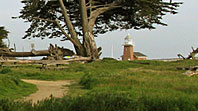 |
| [enlarge] |
Lighthouse Field has served many purposes over the years; now it is an undeveloped park along West Cliff Drive, overlooking Monterey Bay.
Emboldened by their victory at Lighthouse Field, local activists scored further successes. Between 1969 and 1975, they blocked the widening of the major highway through the city and kept a new beach access freeway from destroying several hundred houses in downtown neighborhoods. They also stopped housing developments on the coast just north of the city limits that would have led to a huge population increase: up to 40,000 residents, all of whom were projected to buzz into downtown Santa Cruz on the expanded coastal highway to do their shopping. These victories gave activists the hope that they could accomplish many of their goals by working through government channels. Santa Cruz seemed poised to enter a whole new era of local politics.
But it didn't happen right away. As growth coalition theory would predict, many local citizens returned to their regular pursuits once the threats to their everyday lives were defeated. It was not until 1979 that another set of activists, socialists and feminists who had previously ignored electoral politics to focus on social movements, joined together to elect two of their own members to the city council. In 1981 two more activists from social movements won seats on the seven-person council, and Santa Cruz has been controlled ever since by people to the left of the Democratic Party.
Local activists step up: Patton, Schiffrin, Beiers
The battle to save Lighthouse Field proved to be the testing ground for several local activists who helped carry the progressives to further victories over the next 20 years. In 1974, Gary Patton, a young lawyer hired by the Save Lighthouse Point Association to spearhead the legal side of the fight — and who impressed everyone involved with his legal skills and leadership ability — won a seat on the county Board of Supervisors in the district that includes most of the city and a few adjacent areas north of the city.
Gary Patton
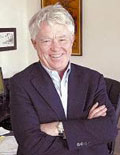 |
Gary Patton (visit his Web site) has been an influential figure in Santa Cruz politics for decades. For his thoughtful and insightful critique of the analysis presented in The Leftmost City, in which he approaches issues from the perspective of democratic government — and also rightly points out that the book did not give much attention to the crucial role of county politics — see his article entitled "My Thoughts on The Leftmost City" on this site.
Patton was a former anti-war activist who had not spent much time on environmental issues until he was hired by the opponents of the hotel and convention center. A recent graduate of Stanford Law School (after doing his undergraduate work at the same university and a year of study at Union Theological Seminary in New York), he won handily in most precincts and by the remarkable margin of 1,815 to 17 on the campus: he got 99.2% of the student vote.
Patton's success, along with victories by two environmentalists in districts outside the city limits in 1972, demonstrated that slow-growth and anti-growth proponents, whether environmentalists or neighborhood activists, now had a strong position at the county level as well as in city government. This in turn meant that Patton could be of assistance in many ways to the opponents of the growth coalition within the city limits. Although control of the five-person county board seesawed back and forth in the second half of the 1970s, Patton's own seat was never seriously challenged again, and activists were able to win permanent control of the county government in 1981. At that point Patton became the de facto leader of all progressive forces in the county for the next 13 years, when he made an unsuccessful run for the state assembly. He then retired from the county board and accepted a position in Monterey as the director of a land-watch organization that tried to protect open lands in a county dominated by its growth coalition. In keeping with the powerful role Patton played between 1974 and 1993, and especially between 1981 and 1993, the Santa Cruz Sentinel later judged him to be one of the two most important people in Santa Cruz in the twentieth century, rivaled only by the colorful boardwalk booster and mayor, Fred Swanton.
Patton's impact was greatly enhanced when he hired one of the Lighthouse Field neighborhood activists, Andy Schiffrin, to be his key aide in county government. A participant in the 1964 Mississippi Freedom Summer, one of the civil rights movement's most important and dramatic efforts, Schiffrin studied sociology at UCLA and planning at MIT, where he became part of the trend toward advocacy planning, and then worked for the Boston Model Cities program as a planner and director of housing development. From the late 1970s until his formal retirement from county government in 2006, he worked with Patton on issues of growth control, affordable housing, and the preservation of open space. In addition, he met regularly with progressive members of the city council to help coordinate the city and county's agenda on a wide range of issues. But it was only in 1981, when the progressives gained control of city government, that those meetings took on major significance. Schiffrin also served in appointed positions in city government concerning planning, housing, and water supply.
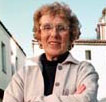 |
| Katherine Beiers (read a 1997 profile of Beiers in Metro |
There were many other activists on Lighthouse Field who continued to work for progressive causes. One of them, Katherine Beiers, an administrator in the UCSC library, was appointed to the city council in 1989 and then won election in her own right in 1990 and 1994. After taking 10 years off from elected office to do many other things, she was elected to the city council again in 2008 with an all-out door-to-door campaign and strong support from student voters on the campus.
Progressive city politics in the 1970s and 1980s
The progressive takeover of political power in Santa Cruz in 1981 that is explained in detail in The Leftmost City did not happen in a vacuum. The decision by previously non-electoral activist groups to challenge in city elections came in a much wider context of progressive analysis, discussion, and political activity at the local level in the 1970s. Its deepest roots were in medium-sized cities such as Madison, Wisconsin, Berkeley, and Santa Monica, although major battles were fought in San Francisco, Boston, and Cleveland as well. These efforts were facilitated by the creation of the Conference on Alternative State and Local Policies in 1974, which brought together progressive activists with elected and appointed officials from across the country for annual meetings to exchange ideas.
The Conference on Alternative State and Local Policies published numerous booklets and pamphlets that disseminated what were thought to be the most promising ideas for progressive social change, including various kinds of electoral reforms such as replacing at-large elections with districts and abolishing the city-manager form of government. Community control of the police was another program of major interest. The group had larger hopes, such as public ownership of "productive enterprise," meaning that cities would own some profit making ventures, as well as for greater citizen participation in all aspects of government. The blueprint for change started with community-owned public utilities, especially electric utilities, where there was a history of public ownership in a few cities and confidence on the part of progressives that they could be run more efficiently than they are by private companies. Ownership of public utilities was understood as a stepping-stone to legitimating public ownership of other enterprises, such as the new industry of cable television, where there were 14 publicly owned TV systems at the time.
More about progressive cities
The progressive city planning movement of the 1970s is carefully described in Pierre Clavel's 1986 book, The Progressive City: Planning and Participation, 1969-1984.
In addition, many historical materials on these efforts are available for Berkeley, Boston, Burlington, Chicago, Cleveland, Hartford, and Santa Monica, through the Progressive Cities and Neighborhood Planning Web site at Cornell University.
The story of rent control as a political issue is told in detail in Stella Capek and John Gilderbloom's 1992 book, Community Versus Commodity: Tenants and the American City.
There was hope for consumer co-ops and community credit unions as well, and there were plans for the creation of affordable cooperative housing, community-controlled social service agencies that would provide an alternative to city agencies, and a model ordinance that would make it necessary for city councils to widen participation on city boards and commissions through a "fair representation" plan that ensured what is now called diversity and neighborhood involvement.
Rent control also emerged as an important goal on the progressive agenda. Rent control had been raised independently in several cities in the early 1970s, including Berkeley, where a strong rent control initiative passed in 1972. The Berkeley initiative led worried apartment owners to try to foreclose further local efforts at rent control with legislation at the state level in 1976. However, a last-minute campaign by activists convinced the liberal California governor, Jerry Brown, to veto the real estate industry's proposed legislation, thereby encouraging further local rent-control initiatives.
Santa Monica became ground zero for rent control in California over the next few years. The failed efforts by senior citizens to pass a rent control initiative there in 1978, combined with arrogant and high-handed rebuffs of renters by real estate interests, who completely dominated the city council, created the motivation for a highly successful coalition effort in 1979. Led by progressive activists, including several who were part of the Campaign for Economic Democracy, a new group called Santa Monicans for Renters Rights passed the strongest rent control measure in the nation in 1979 and carried slates of progressives to city council victories in 1979 and 1981, thereby gaining control of city government in 1981.
But none of the progressive coalitions except the one in Santa Cruz was able to hold on to its gains for a variety of reasons. They became slightly left of center if they survived at all. That's even true of Berkeley, where some of the neighborhood leaders turned against the progressives after they put forth a plan to put government-financed low-income housing in every neighborhood in the city. This attempt at fairness backfired when many neighborhood leaders put a successful initiative on the ballot that divided Berkeley into electoral districts, thereby diluting the importance of the campus voters.
Progressives get elected
The Santa Cruz City Council
Here are some graphics that allow you to visualize the political composition of the Santa Cruz City Council, beginning in the early 1970s; click on the thumbnails to open them in a new window.
 |
The first chart shows the political makeup of the council over time, with members color-coded using the now-familiar "blue = liberal, red = conservative" system. |
 |
The second chart lists each person who has served on the council since 1970, in timeline format. |
Although the Santa Cruz coalition of neighborhood activists, environmentalists, and students seemed headed for control of the city council in 1975 after winning three seats in the 1973 elections, it only held its ground in 1975 and actually lost a seat in 1977, even while defeating specific growth initiatives outside the electoral arena. One of its newly elected members resigned for personal reasons in 1974 and the pro-growth council members replaced her with one of their own, giving them a 5-2 majority. Then in 1975, to everyone's surprise, only one insurgent candidate won: Carole DePalma from the neighborhood group called the Frederick Street Irregulars. She then joined with Sally DiGirolamo, a Frederick Street Irregular elected in 1973, and Bert Muhly, a former county planner turned environmental activist, also elected in 1973, who had the support of downtown centrists as well as students and environmentalists. For the next two years, this threesome was able to win several victories for neighborhoods by gaining the support of a centrist on the council with ties to the growth coalition who nonetheless had pro-neighborhood inclinations on some issues, which is important as far as our theory because it shows that neighborhood coalitions can be centrist — and even reactionary in some cities, when they are built around the exclusion of racial or religious minorities.
With high hopes for finally winning a majority in 1977, DiGirolamo lost in the face of a vicious negative campaign by the growth coalition; the other members of her slate lost, too, leaving DePalma and Muhly in a 5-2 minority. At this point the challengers seemed on the verge of permanent failure, as the turnout of student voters declined and neighborhood voters seemed satisfied with the status quo. But they then received a strong infusion of new energy and activists from an unexpected source: the many non-electoral social movements in the city and county that had built strong social programs for women, the elderly, and low-income children through lobbying, rallies, and street demonstrations. At this point the neighborhood and environmentalist activists, along with the leftists who were now joining them, became known as "progressives."
The organization at the center of the progressive focus on electoral politics in Santa Cruz was an unlikely one: a UC Santa Cruz chapter of a nationwide socialist organization, the New American Movement, which had been founded in the early 1970s by one strand of 1960s New Leftists. Known as "NAM" (rhymes with "wham"), and numbering only 500 to 1,000 members nationally by the mid-1970s, the organization was originally an attempt to start anew as a non-electoral socialist movement that would work on specific popular issues as a way to advocate reform programs that could not be accommodated within a capitalist economic system.
The Santa Cruz chapter of NAM consisted of 15 to 20 undergraduate and graduate students. It began in 1973 as a reading and discussion group, and then became a formal chapter of NAM in the spring of 1974. It had four goals: to contribute to the development of a new socialist-feminist vision; to hold educational forums on campus to introduce students to socialism; to create a local progressive coalition of which it would be one part: and to develop its own off-campus community organization to agitate for a specific reform program. This off-campus project focused on creating support for a community health care center, and it turned out to be the starting point for the unanticipated march to electoral power.
As it is easy to see from the vantage point of the present, the socialist aspect of NAM's work was a failure, but it is still important to emphasize the organization's socialist-feminist orientation because it provided the strong motivation and cohesion for many of those who played a major role in developing the new progressive coalition in Santa Cruz. You have to have high hopes to sustain the kind of effort they made. In addition, the grassroots organizing project itself faltered once the progressive coalition came to power, but building it was essential because it taught NAM members the organizing skills that became highly useful in constructing and holding together the progressive coalition. Such are the ironies of political life. But there is one more, the greatest irony of them all: the socialist-feminists in NAM wanted to convince the people they worked with that socialism was a good idea, but instead they were turned into neighborhood leaders by those they hoped to convert.
In other words, after two years of effort in a neighborhood on the west side of Santa Cruz, NAM had only seven new members, and only 26 local residents showed up to a big neighborhood meeting in October, 1977. But all that began to change when the tax-cutting proposition called Proposition 13 passed in California in 1978 and threatened the revenue base for all the city and county programs that non-electoral activists had developed in many parts of the state over the previous ten years, including Santa Cruz. Now NAM and other activists decided they had to think about winning elections if their programs were to survive.
In reaction to the passage of Prop 13, the county library board voted a month later to close the small west side branch of the city library, smack in the middle of the area NAM had targeted. This abrupt shutdown was both a material and symbolic insult to the neighborhood.
Sensing the anger and annoyance many members of the neighborhood experienced in reaction to this decision, which of course occurred without any consultation with people in the neighborhood, the NAM activists called a meeting for mid-July. It was attended by far more people than they expected, approximately 60 local residents, and led to the founding of a new organization, Westside Neighbors, in an attempt to reverse the library decision. The new organization succeeded in its efforts to have the branch library reopened, but the city council's refusal to respond to any of its other requests over the next year led one NAM leader, Mike Rotkin, to offer to run for city council, even though he had a personal "distaste for electoral politics," as a way to make the group's demands more visible.
Michael Rotkin

Mike Rotkin has donated a few supplemental materials to the Leftmost City web site: you can read a 1979 interview with him and Bruce Van Allen, shortly after they were elected to the City Council; and two chapters from his dissertation: about organizing Westside Neighbors, and about the Santa Cruz chapter of NAM.
Rotkin was right out of the textbook in terms of the kind of activist who went into progressive city politics across the country in the 1970s. As an undergraduate at Cornell in the 1960s he had been a member of Students for a Democratic Society and participated in massive campus demonstrations over the war and racial injustice that gained nationwide attention. He came to UC Santa Cruz in 1969 as a graduate student in a new program, the History of Consciousness, and immediately joined in local activist efforts. He also worked as a lecturer in the Community Studies program discussed earlier. He then was among the founders of the local chapter of NAM.
Rotkin was joined in his effort by another socialist-feminist, Bruce Van Allen, one of the leaders in a downtown neighbors association that had stopped attempts to widen a thoroughfare and expand the downtown. Van Allen was also a mainstay in the effort to bring rent control to the city. He, too, was ready to use electoral politics as a springboard after the rent control organization he helped found, the Santa Cruz Housing Action Committee, came within 74 votes of passing a city rent control initiative in fall, 1978, despite the fact that the real estate interests spent $100,000 to defeat it.
No one thought that Rotkin and Van Allen might win because less radical candidates had suffered defeats in 1975 and 1977. But they stressed their ties to neighborhood groups — Rotkin even called his campaign "Neighbors for a Change" — and received support from student and environmental activists. They won in a rout. Their margins in the neighborhoods they targeted were so large that they didn't even need the overwhelming support they received in the four precincts on the campus. Surprised and elated, they gave an interview to a socialist journal explaining how their election would advance the cause of socialism, and put forth resolutions relating to national issues, but they also joined with other progressive leaders to plan for the 1981 elections with the hope of winning the two more seats to give them a majority.
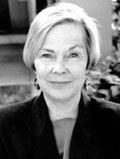 |
| Mardi Wormhoudt (read a 2002 column by Wormhoudt in Metro |
Progressives came up with two ideal candidates. Mardi Wormhoudt was an activist in the downtown neighbors group, a member of local feminist groups, and a participant in efforts to bring a publicly financed health care facility to the west side of Santa Cruz. She would go on to be a major figure in Santa Cruz politics for the next 25 years, retiring as chair of the county board of supervisors in 2006.
John Laird, a UC Santa Cruz alumnus, was a member of the neighborhood group founded by the NAM activists, as well as the Peoples Democratic Club and gay and lesbian organizations. Employed as a county budget analyst, he had helped a wide range of community activist groups prepare their budget requests for presentation to supervisorial meetings in the mid-1970s. He also had taken an active role in the 1978 campaign to defeat a statewide initiative that would have prohibited gays and lesbians from teaching in the public schools. He later went on to be elected to the state assembly in Sacramento, where he played a very important legislative role in the first eight years of this century.
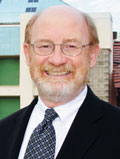 |
| John Laird (read about Laird on Wikipedia) |
The downtown growth coalition pulled out every stop in an effort to defeat Wormhoudt and Laird. They talked about the dangers of socialism, although neither of these two candidates talked about socialism, and they used old scare tactics about outside agitators that turned out not to work any longer. They spent a fortune on advertising. But Laird and Wormhoudt won, and Santa Cruz has been governed by people of their political leanings ever since. In fact, Rotkin served from 1979 to 1988, when he termed out, and then was reelected from 1992 to 2000, and then again from 2002 to 2010.
But by now, in still another irony of this saga, the most leftist member of the original coalition, Rotkin, is known as one of the conservatives in the bunch because he is in favor of improving some tourist facilities so the city will have more money to spend on social programs. He tries to straddle the line between neighborhood/environmental protection and finding ways to bring in more city revenues, as do some of the other members of the progressive coalition, but in fact there is a major division within the progressive coalition between those who emphasize "use values" (quality of life in neighborhoods and the environment in general) and those who emphasize "redistributive issues" (more income, education, medical care, and social services for low-income people). Put another way, the growth coalition has been so successfully vanquished that the progressives have the luxury of being able to fight among themselves. Some of it becomes very ugly and personal.
(The story we've just told here is only a quick overview. It is of course more detailed and complicated, with many fits and starts. That more detailed story is told in chapters 4 and 5 of The Leftmost City.)
Does it matter who governs?
Did it make any difference that the progressives were in charge? Or was it business as usual, as might seem to be the case from a distance?
- The new progressive majority immediately increased spending on social services, doubling it during their first year in office, which was made possible by a decision to postpone infrastructural maintenance projects by one year, creating a rolling fund of several hundred thousand dollars. By the end of the 1980s the progressives had increased social service spending ten-fold: from $150,000 in 1980 to over $1.5 million.
- In addition, the new city council's focus on social welfare was aided greatly by the fact that progressives also won a majority on the county board of supervisors in the 1981 elections, making it possible for the city and county to coordinate their funding of social programs. Due to the very large sums of money spent by Santa Cruz County on social services of all kinds, progressive control of county government played a large role in improving the quality of life for many low-income and otherwise marginalized people in the Santa Cruz area. But all this spending was still a drop in the bucket as far as what is needed. There is still poverty and homelessness in Santa Cruz County even with increased revenues from taxes on motel beds, amusement and movie tickets, and utility services.
- Because of their concern with better working conditions for everyone, the progressive majority also made a difference by starting an affirmative action program for city employees and allowing them to unionize without resistance.
- When a police trainee revealed to a progressive council member that some local police had been systematically brutalizing homeless transients, the ensuing investigation led to the prosecution of six officers and resignations or early retirements by nearly one-third of the police force.
- As part of their efforts to create a popular consciousness that would be supportive of socialism in the future, the progressives held public hearings on a wide range of issues, with the goal of involving more people in government. They passed symbolic resolutions criticizing federal spending priorities, supported disinvestment in South Africa as part of the battle against apartheid, and declared the tiny Santa Cruz Harbor a free trade zone with Nicaragua as a protest against the Reagan Administration's effort to overthrow the Sandinista government. They vetoed plans for an unnecessary dam in the mountains that would have created the oversupply of water that the growth coalition wanted in order to provide a basis for future growth, and they instituted a recycling program.
However, for all their successes and their mutually beneficial coordination with the progressive county government, the progressives on the city council were unable to realize their most ambitious plans. First, and ironically, control of the city council did not lead to an expansion of existing neighborhood groups or the creation of new ones. If anything, the electoral victory had the opposite effect: most groups quickly lost members and declined in importance. Not only did several activists join the city government in one way or another, but most neighborhood residents seemed satisfied to go back to their everyday lives once they had representatives they felt they could trust to look out for their interests, just as growth-coalition theory would expect.
More generally, the progressives proved that they could govern well, be good employers of city staff, protect neighborhoods and the environment, and help low-income people, but they could not realize any of their steps toward socialism. They started out as socialists who wanted to bring about greater participation as well as greater equality in wealth and income, but they ended up as protectors of neighborhood and environmental use values. That is the major irony of their efforts, but it is not a sad irony. They made Santa Cruz a better place to live. Homes were not destroyed by new freeways and highways, as happens in cities controlled by growth coalitions, nor do tall buildings block out sunshine in downtown streets. To the credit of the people who helped build and then rebuild it, Santa Cruz's downtown is about more than shopping.
The moral of the story
For me, this story has a theoretical moral that makes it worth considering by sociologists interested in political power at the urban level: the major conflict in any city in America is between those who want to intensify the use of their land so they can charge higher rents (or sell their land at a higher price) and those who want to protect the quality of everyday life in their neighborhoods. It is a conflict between exchange values (profits) and use values (quality of life). This is a fact that most urban-oriented social scientists still overlook.
For example, there are more urban Marxists — who think the kind of thing that happened in Santa Cruz is a mere reflection of the underlying class struggle between capitalists and workers — than there are advocates of growth coalition theory. Then, too, it goes without saying that anyone who starts with the assumptions underlying free-market economics finds the public choice theory of urban politics more attractive than growth coalition theory even though growth coalition theory begins with the fact that the United States has a market economy and then focuses on the importance of real estate and development.
As for political scientists, they continue to emphasize that many groups can enter into coalitions for a variety of reasons to win what they want on one or another issue, or even to form a regime that governs the city. For them, there is no underlying systemic dynamic that drives the society and shapes politics. Their studies usually show that real estate and development interests dominate city politics, but they flinch from growth coalition theory as readily as they do from Marxism. The beauty of Santa Cruz, aside from its beaches and hillsides, is that the way it was governed from the 1980s through the 2000s showed that Marxists, free-market economists, and political scientists are wrong.
Further reading
For reviews and commentaries on The Leftmost City, some by people who are discussed in the book, click here.
For links to Web sites that tell you what's happening in Santa Cruz now, and a list of books that provide more of the history, personalities,and local color of the city, click here.
This document's URL: http://whorulesamerica.net/santacruz/progressive_politics.html
All content ©2024 G. William Domhoff, unless otherwise noted. Unauthorized reproduction prohibited. Please direct technical questions regarding this Web site to Adam Schneider.

 mobile/printable version of this page
mobile/printable version of this page